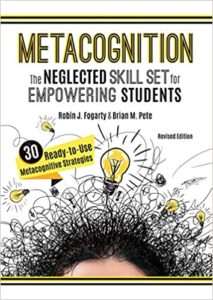Empower Students with Metacognition Skills
Metacognition: The Neglected Skill Set for Empowering Students, Revised Edition
By Robin J. Fogarty and Brian M. Pete
(Solution Tree, 2020 – Learn more)
Reviewed by Jeny Randall

The authors not only provide tools to teach metacognition, but they invite the reader to hone their metacognitive skills as well.
Fogarty and Pete organize the activities into three sections:Planning, Monitoring, and Evaluating. In each, they offer 10 strategies, provide research to show why they work, and then give tips for how and when to introduce them. Each activity concludes with a “One Idea” section that shows the strategy in action.
A book for all ages, adults included

Following each strategy, the authors provide space for the reader to plan, monitor, and evaluate their use of the strategies. They invite readers to jot down ideas sparked by reading the activity, reflect on their implementation of the strategy, and evaluate it with “afterthoughts.” Those who take full advantage of these options will stretch their metacognitive muscles.
Scholars of education will appreciate the attention given to research in each strategy as well as the comprehensive “references and resources” list at the end of the book. I did find the book overall to be somewhat technically written, although anecdotes and examples do help bring the strategies to life. The authors also express their humor with the creative titles given for each strategy, from “rolling the dice” to the “revolving door.”
Fresh tools for familiar strategies
Some of the strategies, such as making inferences (“Pie in the Face,” p. 52) will be familiar to teachers. However, I found both their ideas for introducing the skills and their thoughts about how to encourage a metacognitive approach helped me re-think how and when I teach these strategies.
For example, when teaching conferencing, the authors lay out the skills needed to successfully conference, such as “selecting a partner, finding an appropriate time and place, preparing, responding appropriately, and determining the desired outcomes” (‘Two-way Talk’, p. 143.). They offer several strategies for teaching these skills including modeling, role-playing, recording, and playing back a conference to debrief it.
In addition, they explore when conferring will be the most successful and the different forms it can take. Their “One Idea” focuses on using writing conferences in a science class to help students revise their reports and practice giving constructive feedback to each other.
Other strategies such as bridging (‘Transfer Talk’, p. 151) I’ve modeled in the classroom for years but haven’t considered direct instruction for the skill. But this is exactly the authors’ point. In teaching skills in a metacognitive context, we give students agency in their own learning and increase their ability to self-monitor.
Another gem in Metacognition is the final chapter “In Closing.” The authors explore how metacognition can also be used to develop self-awareness as a vehicle for positive self-change. Fogarty and Pete lay out a series of personal vignettes to highlight “levels of transfer” and provide a final strategy to help students (or readers) move from one level to the next, applying what they have learned to new situations and in fresh and innovative ways.
A practical, easy-to-use book
Metacognition is a practical book. The 30 strategies outlined can be used with little preparation. Since the book is organized by planning, monitoring, and evaluating, it is easy to find strategies that fit your current lesson. These strategies also lend themselves to active and interactive teaching. Strategies like The Human Graph (‘Choose Your Spot’, p. 179) have students on their feet taking a stand on an issue – an active learning strategy that can become a routine learning tool in any classroom.
While readers can use each of these strategies independently, I can see that using them in concert and using them repeatedly can build a habit of metacognition that will continue to serve students well beyond the end of the school year.
Jeny Randall is the Middle School Director and LA teacher at Saratoga Independent School in New York State. She also oversees the curriculum and program development for grades 6 – 8. Jeny is a Responsive Classroom certified teacher. Outside of school, Jeny teaches yoga, reads whatever students send her way, and spends time with her family, outside if possible.


































